Mark Sisson's Blog, page 92
October 20, 2019
Penne Alla Vodka
 These days you can find a wide array of grain-free pastas with genuinely delicious flavor and texture. If you like the taste of pasta but want to limit the pasta carbs, add meat and veggies so less pasta goes further in the dish. Chicken thighs are a great choice to this end. Experiment with adding in veggies like spinach, baby broccoli, mushrooms or bell peppers, and create a variety of versions to your own taste.
These days you can find a wide array of grain-free pastas with genuinely delicious flavor and texture. If you like the taste of pasta but want to limit the pasta carbs, add meat and veggies so less pasta goes further in the dish. Chicken thighs are a great choice to this end. Experiment with adding in veggies like spinach, baby broccoli, mushrooms or bell peppers, and create a variety of versions to your own taste.
For the sauce, use a full-fat coconut milk for the richest flavor, or use traditional full-fat dairy milk or your favorite milk substitute along with our new Primal Kitchen® No-Dairy Vodka Sauce.
Servings: 4
Prep Time: 5 minutes
Cook Time: 30 minutes
Ingredients:
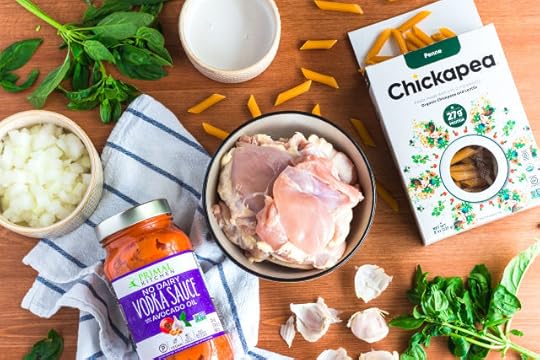
1.5 Tbsp. Primal Kitchen® Avocado Oil or Olive Oil, divided
1 lb. Boneless Skinless Chicken Thighs
1.25 cups chopped Yellow Onion
4 cloves Garlic, grated
½ cup Full Fat Coconut Milk (or other dairy/non-dairy milk of choice)
1.5 cups Primal Kitchen No-Dairy Vodka Sauce
1 box Chickapea Penne Pasta
2-4 Tbsp. Reserved Pasta Water
2 Tbsp. Fresh Shredded Basil
Pinch of Red Pepper Flakes
Salt and Pepper to taste
Instructions:
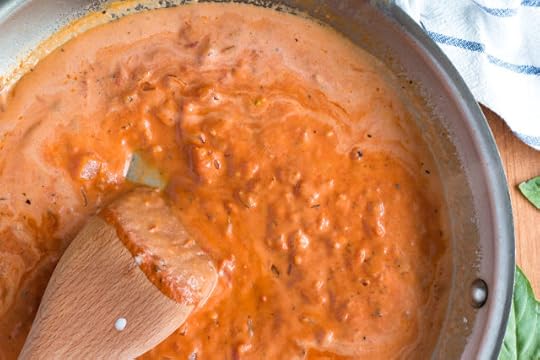
Heat one tablespoon of oil in a pan over medium heat. Sprinkle the boneless chicken thighs with salt and pepper, and add them to the pan once it is hot. Sear for 2 minutes on each side, then cover the pan and reduce the heat to medium-low. Once the chicken reaches an internal temperature of at least 165 degrees Fahrenheit, remove the thighs from the pan and allow them to rest for 5-10 minutes before slicing or cutting into chunks.
In the same pan (or another, whatever you prefer) add the remaining oil and heat it over medium heat. Once hot, add the chopped onion. Stir with a wooden spoon for 3-4 minutes, or until the onion is browned and soft. Add in the grated garlic and heat until the garlic is fragrant. Add in the Vodka Sauce and coconut milk and reduce the heat to medium low. Stir for 1-2 minutes, or until the sauce has thickened and come together.
Prepare the Chickapea pasta according to the directions on the box, but boil the pasta to be slightly undercooked. Drain the pasta, reserving about ¼ cup of pasta liquid. Pour the drained pasta into the pan with the vodka sauce and stir over medium-low heat until the pasta reaches your desired doneness. Add in the chicken and stir. Add the reserved pasta water 1 tablespoon at a time until the sauce reaches the thickness of your liking. Top the pasta with a pinch of red pepper flakes, a sprinkle of salt and pepper and the shredded basil. Enjoy!
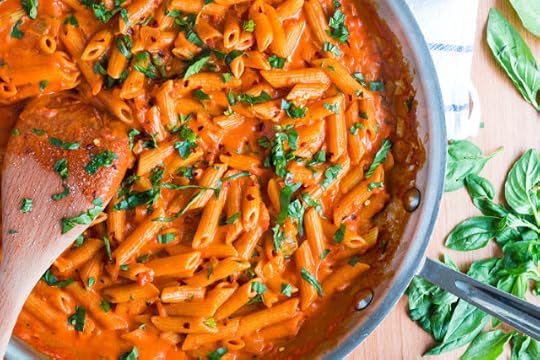
Nutrition Information per serving (1/4 of recipe):
Calories: 547
Total Carbs: 50 grams
Net Carbs: 40 grams
Fat: 21 grams
Protein: 40 grams


The post Penne Alla Vodka appeared first on Mark's Daily Apple.



October 18, 2019
Weekly Link Love — Edition 51

Research of the Week
Manure from cows given antibiotics makes for substandard soil.
Bonobos are bigger meat eaters than we thought.
The Neolithic revolution was more about private property than productivity.
Night owls have worse blood lipids.
For psychiatric symptoms of dementia, non-pharmacologic therapies work better.
New Primal Blueprint Podcasts

Episode 382: Dr. Robert Zembroski: Host Elle Russ chats with Dr. Robert Zembroski, a world-renowned expert in functional medicine and chiropractic neurology and creator of a unique way to enhance conventional cancer treatments.

Primal Health Coach Radio, Episode 30: Laura and Erin chat with Emily Schromm, a serial fitness entrepreneur with a lot of things going on—brick and mortar gym, online courses, and physical products.
Each week, select Mark’s Daily Apple blog posts are prepared as Primal Blueprint Podcasts. Need to catch up on reading, but don’t have the time? Prefer to listen to articles while on the go? Check out the new blog post podcasts below, and subscribe to the Primal Blueprint Podcast here so you never miss an episode.
Media, Schmedia
Dutch farmers take to the streets.
Baby food, now with lead and arsenic!
Interesting Blog Posts
Why ketogenic diets as clinically practiced are unhelpful for mitochondrial diseases.
Are Nike’s superfast running shoes a problem?
Social Notes
I recently participated in Dr. Bill Schindler’s Modern Stone Age Diet online summit and had a great time. Check out talks from me, Robb Wolf, and dozens more.
Everything Else
The rush to harvest organs is affecting death investigations.
Even though some residents left city limits to buy cheaper soda, a soda tax in Philadelphia reduced overall soda consumption.
Things I’m Up to and Interested In
Video I enjoyed: Sioux chef.
Another video I enjoyed (well, sorta): Why seed oils are so harmful.
I’d try it: Bog butter.
I’m not surprised: Persistent low-grade inflammation is a common feature of depression.
Ancient humans didn’t mess around: Not only were we utilizing brain tissue and bone marrow, we were processing and consuming “dental pulp.”
Question I’m Asking
With Google stopping development of its glucose-monitoring lens and all the other failures and dubious advancements, tech is realizing that biology’s a hard nut to crack. Do you think technology will ever figure out human biology and vault us into sci-fi territory?
Recipe Corner
Taco chili? Taco chili.
Paleo eggs benedict won’t betray you.
Time Capsule
One year ago (Oct 12 – Oct 18)
Why “Is It Keto?” Is the Wrong Question – It’s not the point.
Dear Mark: Omega-6 Deficiency and Saw Palmetto – A couple questions.
Comment of the Week
“Hey Mark,
You’re usually way out in front but my 13-year-old son actually beat you to it this time. He, like most his age, is an avid Youtube watcher and has recently gotten into watching the ways of searing the perfect steak.
He’s been hammering me to get a cast iron skillet. Lol.
If it were up to him we’d eat steak every night.
Gotta say, of the obsessions I’d want my 13-year-old son to have, the perfect sear on a Steak works for me!”
– Now that’s awesome, Joel.

The post Weekly Link Love — Edition 51 appeared first on Mark's Daily Apple.



October 17, 2019
The Power of Red Light Therapy (and a Giveaway…)
 Today’s post is offered up by the good people at Joovv, a company devoted to researching and harnessing the science of red light therapy. I’ve gotten to know (and love) their technology over the last year, and my family has, too—especially my daughter and son-in-law. Today I’ve invited Scott Nelson and his team to share some of their research into red light therapy, a topic I’ve written about now and then over the last few years. It’s an area of ancestral health I find fascinating—and one where modern science can help us recreate or even enhance natural ancestral inputs to foster better well-being today. Enjoy—and be sure to check out the giveaway below.
Today’s post is offered up by the good people at Joovv, a company devoted to researching and harnessing the science of red light therapy. I’ve gotten to know (and love) their technology over the last year, and my family has, too—especially my daughter and son-in-law. Today I’ve invited Scott Nelson and his team to share some of their research into red light therapy, a topic I’ve written about now and then over the last few years. It’s an area of ancestral health I find fascinating—and one where modern science can help us recreate or even enhance natural ancestral inputs to foster better well-being today. Enjoy—and be sure to check out the giveaway below.
Diet and fitness are the pillars of a healthy life built on ancestral principles. But food, water, and exercise aren’t the only factors that affect your health and function on a day-to-day basis. Natural light is also a major pillar of a healthy, ancestral lifestyle, and unfortunately, many people don’t get nearly enough of it.
You can complement your diligence in the kitchen and your hard work in the gym with the “nutrients” that come from natural light. This post gives an overview of photobiomodulation (aka “red light therapy”), a natural health intervention that’s helping people get the light their bodies need for optimal health and fitness.
The Problem With Modern Light Exposure
Our Ancestors Lived with an Abundance of Natural Light. We Don’t Get Nearly Enough.
One of the biggest differences between our modern lives and those of our ancestors is the amount of time we spend outside and how much natural light we experience every day. Even if you’re eating well on a Paleo or Keto diet and exercising every day, odds are you spend most of your days indoors. In fact, the average American spends more than 90% of their time inside. [1] That’s not nearly enough natural light for our bodies, and it’s a far cry from our ancestors’ lifestyles.
In the past, people were outdoors every day out of necessity. The human body and our biology evolved in the presence of lots of sunlight, and light is still essential to our health. It helps regulate our sleep cycle, powers our cells and energy production, which allows our bodies to function as they were intended.
To make matters worse, we’re currently faced with a modern light problem as well. All of our overhead lighting, plus the bright blue light from our phones, TVs, and computer screens, is negatively affecting our health. Many of our sleep problems can be traced back to the abundance of bright, artificial light we take in at all hours of the day. [2]
Similar to how our diets have grown to include more grains and processed foods, and our physical activity has dwindled as we became more sedentary, the negative effects of artificial light combined with a lack of natural light have separated us even further from the roots of good health.
Using Red Light Therapy to Get the Natural Light You Need
Jobs, school, busy schedules, and changing seasons prevent many of us from getting outside every day, even if we want to. That’s where red light therapy comes into play: it’s a natural, noninvasive health intervention you can use in your home to get a full day’s worth of natural light, even if you can’t get out in the sun.
Light therapy is a non-invasive, convenient treatment that powers your cellular function with concentrated, natural light. This natural light stimulates the mitochondria in your cells, which helps you produce more adenosine triphosphate (ATP), which is used by your body for muscle and skin healing, pain relief, and clearer skin. We’ll get into detailed health benefits later, but check out Joovv’s learn library now if you want to dig in now.
Many people are still in the dark when it comes to red light therapy. There’s a lot to know and a lot of misleading information out there. Let’s explore what red light therapy is, how it works, and how it can help maximize your health and Paleo goals.
How Does Red Light Therapy Work?
A quality red light therapy device—like a Joovv— delivers concentrated wavelengths of natural red and near infrared light directly to your skin and cells. All you really have to do is sit or stand in front of the light for a few minutes every day. In other words, red light therapy is very easy to do, but it produces some pretty incredible health results that have been demonstrated across hundreds of peer-reviewed clinical studies.
On top of ATP production, red light therapy increases circulation and reduces oxidative stress associated with cell injury and things like muscle fatigue, joint pain, and inflammation. A treatment only takes 10-15 minutes with a professional-grade device. Because red light therapy is natural and non-invasive, there are virtually no side effects or risks either.
Red light therapy is backed up by a large base of clinical research, originally driven by NASA’s involvement in the 1990s. After that, red light therapy devices could only be found in expensive and exclusive spas. With advancements in LED technology, combined with more awareness of the therapy, there are now many light therapy devices on the market. We’ll break down some of the most important factors to consider in a light therapy device towards the end of this post.
Natural Health Benefits of Red Light Therapy
The benefits of red light therapy are backed up by a large base of clinical research. Here are some of the most studied and well-documented health benefits, complete with links to the published and peer-reviewed studies:
More Restful Sleep and a Healthy Circadian Rhythm with Red Light Therapy
Light exposure is one of the biggest factors in our sleep quality, and it also has a major impact on our sleep cycles, a.k.a. our Circadian Rhythm. Our bodies and brains take cues from the light we’re receiving at any given time. For example, when we get way too much bright, artificial light in the evenings, our bodies get the signal that it’s time to be awake. [3]
Light therapy helps your body produce more natural melatonin, unlike artificial blue light, which hinders your body’s melatonin production. Many people will take supplements and sleep aids to boost melatonin, but it’s much healthier and more effective for your body to make its own melatonin. [4]
Light therapy has also been found to improve sleep quality and duration for people suffering from severe sleep disorders due to migraines as well as traumatic brain injuries. [5,6]
For a full overview of how red light therapy helps you sleep, check out this post.
Improving Physical Performance and Muscle Recovery with Natural Light
Muscle cells require a lot of energy, and show significant improvements with natural light treatments. In study after study, red light therapy has been found to enhance physical performance when paired with exercise. [7] That’s a big reason why so many pro athletes and personal trainers have incorporated red light therapy systems into their training facilities.
Red light therapy improves speed, strength, and endurance for women and men, and people at every level of fitness. [8,9] Researchers looking at red light’s effects specifically on middle-aged and older women of all fitness levels saw the same performance enhancing qualities. [10] And after an intense workout, red light therapy reduces post-exercise muscle fatigue and has also been found to help people recover more quickly after exertion. [11,12]
It only makes sense that when you give your body and muscles the fuel they need, they’re going to perform better, and heal and recover faster. Check out this article for a rundown of all the ways red light therapy enhances physical performance and muscle recovery.
Red Light Therapy for Joint Pain and Inflammation
Light therapy has a natural anti-inflammatory effect. [13] Natural light treatments increase circulation and helps clear out the swelling that keeps us feeling sluggish. This anti-inflammatory effect is what helps people recover from surgery while reducing their pain. [14] Reducing inflammation has a big effect on joints and pain too. Researchers have also found red light therapy to be a helpful natural treatment for rheumatoid arthritis, hand osteoarthritis, and knee osteoarthritis. [15,16,17]
Here’s an informational article to learn more about joint pain relief with red light therapy. And here’s another helpful article about reducing inflammation.
Better Cognitive Function with Natural Light
The most important muscle of all—your brain—also performs better when your body is exposed to healthy, natural light. In one of the first human studies to test cognitive performance and red light therapy, researchers found the light treatments improved reactions times, increased memory, and boosted positive moods. [18] Light therapy has even been found to help treat Alzheimer’s Disease and dementia symptoms in some very encouraging preliminary research. [19,20]
Check out this article to learn more about red light therapy’s positive effect on brain health and cognitive functions.
More Collagen and Healthier, Younger-Looking Skin with Natural Light
Collagen is essential to your physical function. Red and near infrared light has been found to naturally increase collagen production, which is critical for skin health too. [21] Thanks to the collagen increasing properties of light therapy, treatments have been found to reduce fine lines and wrinkles as well as other signs of aging, leading to all-around clearer, younger-looking skin. [22] Researchers have found specifically that light therapy is beneficial in helping children recover from scars and helping middle-aged women look younger. [23,24]
These collagen and skin benefits are why you’re seeing more skincare professionals like estheticians and dermatologists offer red light therapy treatments in their practices. Here’s an informational article you can check out to get the full picture on the rejuvenating benefits of red light therapy.
What to Look For in a Red Light Therapy Device
There are numerous red light therapy options out there. So where do you start? What should you look for in a red light therapy device? The basics are size & coverage, power, and design quality. Let’s look at these major factors to help you pick the best device for your health needs.
Bigger Devices for More Coverage
The most important and simplest thing to remember when it comes to red light therapy devices is that bigger is better. Medical professionals and independent diagnostic testing labs agree that bigger devices that offer full-body coverage are more effective than smaller devices that only treat targeted areas.
A larger coverage area translates to more of your body that is able to take in the energy in natural light. And the more your body can take in, the more your cells can use that energy and the more positive health effects you’re going to see. Don’t fall for a cheap, small device that advertises big power and benefits.
With a larger device, you’re getting more total light energy, which takes irradiance and surface area coverage into account. Harvard Medical School photomedicine researcher Dr. Michael Hamblin, a member of Joovv’s scientific advisory board, explains why total delivered energy is needed:
“Total light energy is the most accurate and comprehensive way to measure the power of light therapy devices and treatments,” says Dr. Hamblin. “If you only account for irradiance—versus how much total energy a device delivers—you miss the larger picture of how light therapy positively benefits the person using it.”*
Power Matters, and So Does Independent Verification
Beyond size, the main spec you’ll want to look for is total energy, or how much clinical power the device can deliver to your skin and cells. One issue you might run into with power stats is how easy it is for a company to throw out a big number without much behind it. You’re going to see a lot of red light therapy companies make claims about the power of their devices. One quick way to see through their claims is to make sure they have had these power specs verified by an independent testing lab.
Joovv contracted ITL (Independent Testing Laboratory) to conduct a series of radiometry tests on our devices and the devices are other light therapy brands to verify the claims made by different companies. Those independent results showed that Joovv offered the most powerful light therapy available.
So many of the small and cheap devices you’ll find haven’t been tested independently. There’s no way to know if the numbers they throw around are valid or not. What’s worse is that a lot of these devices aren’t registered with the FDA either, nor do they follow GMP (Good Manufacturing Practices), which makes sure products are up to the industry-regulated quality standards.
Design Quality and Versatility
There are a wide variety of red light therapy devices on the market right now. Some look like space-age showerheads, some look like orbs you hold in your hands and move around your body. There are even some that you wear like a belt or a shirt.
Most companies offer a single device that is meant to be your only purchase, a one-and-done approach that amounts to “you get what you get.” Joovv’s patented modular design is unique in the light therapy world, and allows you to start with a smaller device and build it into a larger one over time by adding more lights for more power and coverage, as needed. Joovv’s devices work together and can pair up to form larger, full-body systems like the pros use.
Joovv is known for its larger, full-body devices, but we also make a portable handheld model called the Joovv Go that’s ideal for clinical-grade light therapy away from home.
Better Health and Fitness with Red Light Therapy
Our ancestors thrived on lots of natural light, and our bodies are still designed to function that way. We’ve gotten away from these principles and surrounded ourselves with unhealthy artificial light almost 24/7. With red light therapy, it’s possible to still get the natural light your body needs every day, in the comfort of your home.
Red light therapy is backed by hundreds of peer-reviewed, clinical studies and analyses that show significant improvements in sleep quality, skin health, muscle performance and recovery, joint pain relief, inflammation relief, and improved cognitive function. A common theme across these studies is that natural light treatments from a medical-grade device like a Joovv have virtually no side effects or risks.
If you’re looking for a natural health intervention that fits the paleo or keto lifestyle, consider getting more natural light every day with a quality light therapy device.
Now, For the Giveaway…
Intrigued? Interested to learn more or give it a go? Why not enter to win a Joovv device?
I’ll be choosing two random winners to receive a Joovv Go, plus $100 in Primal Kitchen® products.
Enter to Win:
1. Follow @marksdailyapple + @joovvsocial on Instagram
2. Tag your buddies in the giveaway announcement IG post.
The winners will be announced and contacted via direct message on Instagram on October 22, 2019. Good luck, folks!
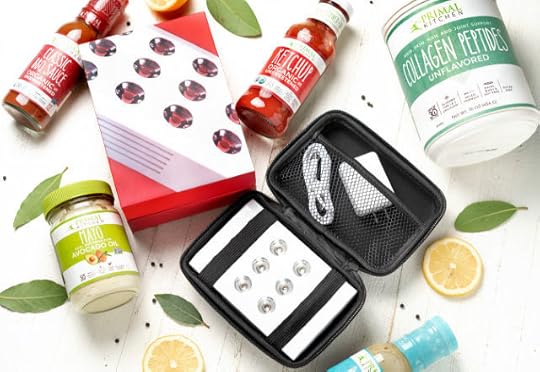

Sources and References:
[1] Klepeis NE, Nelson WC, Ott WR, et al. The National Human Activity Pattern Survey (NHAPS): a resource for assessing exposure to environmental pollutants. J Expo Anal Environ Epidemiol. 2001 May-Jun.
[2] Lunn RM, Blask DE, et al. Health consequences of electric lighting practices in the modern world: A report on the National Toxicology Program’s workshop on shift work at night, artificial light at night, and circadian disruption. The Science of the Total Environment. 2017 Dec 31
[3] Moore, R. “Suprachiasmatic nucleus in sleep-wake regulation” Sleep Med. 2007, Dec 8
[4] Morita T., Tokura H. “ Effects of lights of different color temperature on the nocturnal changes in core temperature and melatonin in humans” Journal of Physiological Anthropology. 1996, September
[5] Loeb LM, Amorim RP, et al. “Botulinum toxin A (BT-A) versus low-level laser therapy (LLLT) in chronic migraine treatment: a comparison.” Arquivos de neuro-psiquiatria. 2018 Oct
[6] Naeser MA, Zafonte R, et al. “Significant improvements in cognitive performance post-transcranial, red/near-infrared light-emitting diode treatments in chronic, mild traumatic brain injury: open-protocol study.” Journal of Neurotrauma. 2014 Jun
[7] Leal-Junior EC, Vanin AA, et al. Effect of phototherapy (low-level laser therapy and light-emitting diode therapy) on exercise performance and markers of exercise recovery: a systematic review with meta-analysis. Lasers in Medical Science. 2015 Feb
[8] dos Santos Maciel T, Muñoz I, et al. Phototherapy effect on the muscular activity of regular physical activity practitioners. Lasers in Medical Science. 2014 May
[9] Dellagrana RA, Rossato M, et al. Photobiomodulation Therapy on Physiological and Performance Parameters During Running Tests: Dose-Response Effects. Journal of Strength and Conditioning Research. 2018 Oct
[10] Paolillo FR, Corazza AV, et al. Phototherapy during treadmill training improves quadriceps performance in postmenopausal women. Climacteric. 2014 Jun.
[11] Leal Junior EC, Lopes-Martins RA, Dalan F, et al. Effect of 655-nm low-level laser therapy on exercise-induced skeletal muscle fatigue in humans. Photomed Laser Surg. 2008 Oct
[12] Borges LS, et al. Light-emitting diode phototherapy improves muscle recovery after a damaging exercise. Lasers in Medical Science. 2014 May
[13] Hamblin M. “Mechanisms and applications of the anti-inflammatory effects of photobiomodulation”. AIMS Biophys. 2017
[14] Langella L., Casalechi H., Tomazoni S., Johnson D., Albertini R., Pallotta R., Marcos R., de Carvalho P., Leal-Junior E., “Photobiomodulation therapy (PBMT) on acute pain and inflammation in patients who underwent total hip arthroplasty-a randomized, triple-blind, placebo-controlled clinical trial”. Lasers Med Sci. 2018 Jun.
[15] Brosseau L, Welch V, et al. Low level laser therapy for osteoarthritis and rheumatoid arthritis: a meta-analysis. The Journal of Rheumatology. Aug 2000
[16] Paolillo AR, Paolillo FR, et al. Synergic effects of ultrasound and laser on the pain relief in women with hand osteoarthritis. Lasers in Medical Science. Jan 2015
[17] de Paula Gomes CAF, et al. Incorporation of photobiomodulation therapy into a therapeutic exercise program for knee osteoarthritis: A placebo-controlled, randomized, clinical trial. 2018 Oct
[18] Barrett DW, et al. Transcranial infrared laser stimulation produces beneficial cognitive and emotional effects in humans. 2013 Jan.
[19] Berman MH, Halper JP, et al. Photobiomodulation with Near Infrared Light Helmet in a Pilot, Placebo Controlled Clinical Trial in Dementia Patients Testing Memory and Cognition. Journal of Neurology and Neuroscience. J Neurol Neurosci. 2017 feb.
[20] Saltmarche AE, Naeser MA, et al. Significant Improvement in Cognition in Mild to Moderately Severe Dementia Cases Treated with Transcranial Plus Intranasal Photobiomodulation: Case Series Report. Photomedicine and Laser Surgery. 2017 Aug.
[21] Barolet D, Roberge CJ, et al. Regulation of skin collagen metabolism in vitro using a pulsed 660 nm LED light source: clinical correlation with a single-blinded study. Journal of Investigative Dermatology. 2009 Dec.
[22] Wunsch A and Matuschka K. A Controlled Trial to Determine the Efficacy of Red and Near-Infrared Light Treatment in Patient Satisfaction, Reduction of Fine Lines, Wrinkles, Skin Roughness, and Intradermal Collagen Density Increase. Photomedicine and Laser Surgery. 2014 feb.
[23] Alsharnoubi J, Shoukry K, et al. Evaluation of scars in children after treatment with low-level laser. Lasers in Medical Science.
[24] Kim HK, Choi JH. Effects of radiofrequency, electroacupuncture, and low-level laser therapy on the wrinkles and moisture content of the forehead, eyes, and cheek. Journal of Physical Therapy Science. 2017 Feb.
The post The Power of Red Light Therapy (and a Giveaway…) appeared first on Mark's Daily Apple.



October 16, 2019
A Primal Guide to Blood Pressure: 8 Common (and Not So Common) Interventions
 Hypertension is a problem. It raises the risk of heart disease; it’s one of the most consistent risk factors for that condition, as well as others like kidney disease. But before you start freaking out about your high blood pressure, make sure you actually have it. A single elevated reading does not a hypertension diagnosis make. Readings are snapshots in time. They can be a part of a trend, or they can be an isolated case. Don’t assume based on one bad reading.
Hypertension is a problem. It raises the risk of heart disease; it’s one of the most consistent risk factors for that condition, as well as others like kidney disease. But before you start freaking out about your high blood pressure, make sure you actually have it. A single elevated reading does not a hypertension diagnosis make. Readings are snapshots in time. They can be a part of a trend, or they can be an isolated case. Don’t assume based on one bad reading.
I can remember going to the doctor about ten years ago for a routine checkup, showing 140/100, and almost getting a prescription based on that. It was absurd, so absurd that I took matters into my own hands and got a fancy blood pressure device to measure my own over the next couple weeks. The result?
There was almost no pattern. Maybe it was a lot lower after dinner, due to relaxation, but other than that there weren’t any trends. Sometimes it was high, mostly it was low-normal. It all depends on stress
Okay, say that’s not you. Say you have a legitimate problem with protracted and consistently high blood pressure. What can you do in addition to (or besides, if your doctor says it’s safe to wait) opt for the prescription?
1) Eat More Potassium
A common cause of salt-related blood pressure increases is inadequate potassium intake. Very few of us eat as much potassium as we evolved eating.
The pre-agricultural environment was potassium-rich and sodium-poor. That’s why we have a physiological taste for salt, and why salted food tastes so good: we had to seek it out. That’s why we don’t have a physiological taste for potassium: it was everywhere. Loren Cordain estimates some hunter-gatherer groups got upwards of 10-12 grams of potassium a day, whereas the average American gets about 2.5 grams.
Studies show that both sodium-sensitive and potassium-deficient subjects with high blood pressure see the biggest improvements with increased potassium intake.
I love sodium, and it’s actually beneficial for endothelial health when consumed with enough potassium, but you have to eat potassium too.
2) Improve Your Insulin Sensitivity
Ever since earlier studies established that hypertensive patients tend to exhibit abnormally high insulin responses to standard glucose loads, researchers have wondered about a connection between insulin and blood pressure. It turns out there is a powerful connection.
In non-diabetic people with normal blood pressure, insulin levels and shifts in blood pressure are related—higher insulin, higher blood pressure; lower, lower.
In both diabetic and non-diabetic subjects, lower insulin sensitivity predicts elevated blood pressure.
Insulin increases sodium retention in the blood, which increases blood volume and pressure. The less insulin sensitive you are, the more insulin you’ll release in response to a given stimulus, and the more sodium you’ll shuttle into the blood.
Both insulin resistance and the compensatory hyperinsulinemia (elevated insulin levels) that results have distinct pro-hypertensive effects.
Luckily, there are dozens upon dozens of ways to improve your insulin sensitivity. Choose a few, or all of them (a better proposal, actually), to not only improve your blood pressure but also your health and life in general.
3) Earn Your Carbs With Physical Activity
The ones you earn through physical activity, that is. Let’s look at two scenarios.
First: You eat way more carbs than you actually earn through training. You haven’t trained, so you’re more insulin-resistant than the You from the alternative universe who did train. This means any carbs you eat will cause a greater spike in insulin, which has been shown to increase blood pressure.
Second: You only eat the carbs you’ve earned through training. Since you’re training, your insulin sensitivity is high, and you don’t actually secrete all that much insulin in response to the carbs. Training also upregulates non-insulin dependent glycogen repletion, meaning you can shove glycogen into muscles post-workout without even using insulin.
Once or twice, this isn’t an issue. But if you’re consistently eating more carbs than you need, the resultant elevation in insulin will raise blood pressure. At the very least, it won’t help.
Not only that, but regular training improves endothelial function and reduces the risk of high blood pressure on its own.
4) Eat Fermented Dairy
Milk fermented with the L. helveticus bacteria has been shown to lower blood pressure in people with hypertension in a number of studies.
In one, they drank the fermented milk for 21 weeks.
In another, they drank the milk for 10 weeks.
Look for products that include Lactobacillus helveticus, such as kefir, aged cheese (Swiss, emmental, pecorino romano, cheddar, parmigiano reggiano),
5) Get Your Zinc (Red Meat and Oysters)
Zinc is an essential nutrient for regulating the nitric oxide synthase system in the body. Without adequate zinc, your ability to produce nitric oxide—which increases blood vessel dilation and thus regulates blood pressure—is hampered.
6) Get Sunlight
There are consistent relationships between adequate vitamin D levels and normal blood pressure, though it’s unclear whether this is causal. Studies haven’t found a consistent blood pressure effect of actually supplementing with vitamin D. What might be going on is that vitamin D is acting as a marker for sun exposure, because we know that sunlight increases the production of nitric oxide, a compound that improves the function of your blood vessels.
Sure enough, human studies show that sun exposure causes the conversion of nitrogen oxide in the skin to nitric oxide, lowering blood pressure and improving endothelial function.
7) Address Your Stress
Stress might be the biggest trigger for hypertension, especially since most of us live lives laden with hidden, inevitable stressors—commutes, jobs we don’t like, bills, and the like. It’s everywhere, we can’t really escape it entirely, so we have to figure out how to deal with it.
I know how I do it (paddling, Ultimate, walks, quality time with family, smart supplementation). There are other ways, like adaptogens, or this, or this. You can rethink stress entirely. You can meditate, or try alternatives that achieve similar things. What are you going to do?
If your blood pressure is resistant to dietary, exercise, or lifestyle changes, make sure you manage it with your doctor.
8) Take ACE Inhibitors or AR Blockers If Warranted
The body uses a hormone called angiotensin to raise blood pressure in a couple ways. First, by directly constricting blood vessels and increasing flow pressure. Second, by promoting the release of aldosterone, a hormone that shuttles sodium to the blood to increase blood volume. ACE inhibitors inhibit angiotensin secretion and AR blockers block angiotensin receptor sites. While I know we’re usually suspicious of drugs that block or inhibit the secretion or action of hormones, ACE inhibitors and AR blockers appear to be quite safe and effective. And there’s even evidence that normotensive subjects who take them live longer than normotensive subjects who don’t.
They do tend to lower zinc status, though, so keep up with your zinc intake.
That’s it for today, folks. The good news is that high blood pressure is manageable with diet and lifestyle changes, and even if that doesn’t work, the available medications seem better than most.
How do you manage your blood pressure? What’s worked? What hasn’t?

References:
Sebastian A, Cordain L, Frassetto L, Banerjee T, Morris RC. Postulating the major environmental condition resulting in the expression of essential hypertension and its associated cardiovascular diseases: Dietary imprudence in daily selection of foods in respect of their potassium and sodium content resulting in oxidative stress-induced dysfunction of the vascular endothelium, vascular smooth muscle, and perivascular tissues. Med Hypotheses. 2018;119:110-119.
Filippini T, Violi F, D’amico R, Vinceti M. The effect of potassium supplementation on blood pressure in hypertensive subjects: A systematic review and meta-analysis. Int J Cardiol. 2017;230:127-135.
Takano T. Anti-hypertensive activity of fermented dairy products containing biogenic peptides. Antonie Van Leeuwenhoek. 2002;82(1-4):333-40.
Seppo L, Jauhiainen T, Poussa T, Korpela R. A fermented milk high in bioactive peptides has a blood pressure-lowering effect in hypertensive subjects. Am J Clin Nutr. 2003;77(2):326-30.
Jauhiainen T, Vapaatalo H, Poussa T, Kyrönpalo S, Rasmussen M, Korpela R. Lactobacillus helveticus fermented milk lowers blood pressure in hypertensive subjects in 24-h ambulatory blood pressure measurement. Am J Hypertens. 2005;18(12 Pt 1):1600-5.
The post A Primal Guide to Blood Pressure: 8 Common (and Not So Common) Interventions appeared first on Mark's Daily Apple.



October 15, 2019
Dear Mark: Collagen or Glycine, Keto and Gallstones, Raw Liver, Stevia Itching, and Gaining Muscle, Losing Fat
 For today’s edition of Dear Mark, I’m answering five questions taken from this Twitter thread. First, does collagen offer anything special above and beyond glycine? Second, what’s the relationship between keto and gallstones? Third, do I recommend eating raw liver, and why or why not? Fourth, why does one reader’s scalp itch when eating stevia? And finally, what’s the best way to lose fat and gain muscle at the same time?
For today’s edition of Dear Mark, I’m answering five questions taken from this Twitter thread. First, does collagen offer anything special above and beyond glycine? Second, what’s the relationship between keto and gallstones? Third, do I recommend eating raw liver, and why or why not? Fourth, why does one reader’s scalp itch when eating stevia? And finally, what’s the best way to lose fat and gain muscle at the same time?
Let’s go:
If collagen is broken down into amino acids in the gut before being absorbed, is it just the amino acid profile (i.e. high glycine) that makes it so beneficial? Anything else?
Glycine is a major reason why we need collagen in our diets, but it’s not the only one.
When you feed people collagen derived from pork skin, chicken feet, and cartilage, many different collagenous peptides appear in the blood. You don’t get any of these from isolated glycine:
Proline-hydroxyproline, a peptide with protective effects on osteoarthritic cartilage degradation.
Glycine-proline-hydroxyproline, a peptide that makes it into the blood and turns into proline-hydroxyproline, which makes it into the skin.
Collagen peptides have beneficial effects above and beyond glycine alone—although glycine is great for balancing out methionine intake from muscle meat consumption. It’s also been used in several studies to improve multiple markers of sleep quality.
A family member has a complicated health history including cancer and wants to eat keto. But, now she finds she has gallstones. Any thoughts on a good way to attack this complicated issue?
Has your family member already gone keto? Did going keto come before the gallstone reveal?
If so, that’s actually normal.
The primary role of the gallbladder is to collect bile from the liver, concentrate it into potent super-bile (my term), and release the concentrated bile to break up incoming dietary fat into smaller molecules that lipase can attack and digest. Dietary fat is the biggest driver of gallbladder emptying.
If the gallbladder isn’t regularly emptied, gallstones can form. Usually made of hardened cholesterol, gallstones are quite common and often produce no symptoms. Problems arise when normal gallbladder emptying flushes out a stone small enough to make it into but too large to pass through the bile duct and a blockage occurs. Gallstones can also directly damage the walls of the gallbladder, leading to cholecystis, or gallbladder inflammation.
A high-fat diet can exacerbate or even uncover gallstone issues by increasing gallbladder emptying. Remember: the more fat you eat, the more often you empty your gallbladder—and everything in it.
But high-fat diets don’t generally cause gallstones to form. They only reveal pre-existing ones. The biggest risk factors for gallstone formation are:
A high intake of high-glycemic carbohydrates.
High estrogen levels, which concentrate cholesterol deposition in the gallbladder. This is why women, especially pregnant women and/or those taking hormonal birth control, are more likely to have gallstones.
Obesity, which also increases cholesterol levels in the gallbladder.
Weight loss, with a caveat: high-fat weight loss diets reduce and even prevent gallstone formation. In fact, when you compare people who lose weight on a low-fat diet to those who lose it on a high-fat diet, research shows that 45% of the low-fatters develop gallstones while none of the high-fatters develop them.
Once the gallstones are all clear, keep up with the keto eating, as eating more fat will keep your gallbladder regularly flushed and clear of stones.
Is Raw Liver safe to eat?
I’ve eaten raw liver before. I know people who eat raw liver. I can’t recommend it, however, because I don’t know what kind of liver you have access to. Who raised the animal? What did it eat? What were the processing conditions?
But because I know people are going to try this…
Freeze it first for several days.
Buy from a trusted source.
Buy only liver from well-raised, grass-fed, organic animals.
If it looks unhealthy, it probably is. I would never eat a pale, flaccid liver with ugly spots, cooked or raw.
Don’t eat raw (or even medium) pork liver. A huge percentage of pigs carry the Hepatitis E virus, which is transmittable to humans and concentrates in the liver.
Why does stevia make my scalp itch?
Stevia can be an allergen actually. It’s not very common, but as more and more people use stevia, more will be revealed to have an allergic reaction.
I’d just skip it.
Is it possible to gain muscle and lose weight with properly timed IF around workouts?
It is possible, although you may not actually lose weight, but rather body fat (which is better).
The best way I’ve seen people do it is the classic Leangains method.
Fast from 8 p.m. to 12-1 noon.
Fasted workout in the afternoon, perhaps with a little BCAA or whey isolate before the workout. Lift heavy, compound movements.
After the workout, walk for 20 minutes. Brisk pace to utilize all the free fatty acids swimming around.
Then eat. If you’re going to eat carbs, do it in this meal and keep the fat low-to-moderate. Load up on protein.
Eat as much as you like until 8 p.m.—the end of your eating window. Favor protein and, again, if you’re eating carbs keep fat lower than usual.
Maintain the fasting period every day. On rest days, eat low/no carb and higher fat. Protein always high. Go for walks on rest days.
That’s it. That usually works really well, but it presupposes you have a flexible schedule and can actually train in the afternoon whenever you want. Your mileage may vary—though it will work at any time.
Muscle gain won’t be as rapid as it would drinking a gallon of milk a day, eating pizza smoothies, and cramming ice cream made with whey protein at night, but it will minimize fat gain and perhaps even help you lose fat as you gain muscle. No guarantees, but it’s the best method I’ve seen.
That’s it for today, folks. Thanks for reading, take care, and be sure to leave a comment down below if you have any questions.

The post Dear Mark: Collagen or Glycine, Keto and Gallstones, Raw Liver, Stevia Itching, and Gaining Muscle, Losing Fat appeared first on Mark's Daily Apple.



October 14, 2019
I Realized I Didn’t Need To Deprive Myself Anymore
It’s Monday, everyone! And that means another Primal Blueprint Real Life Story from a Mark’s Daily Apple reader. If you have your own success story and would like to share it with me and the Mark’s Daily Apple community please contact me here. I’ll continue to publish these each Monday as long as they keep coming in. Thank you for reading!

Yup, success stories are back! And I’m looking for more. Follow-ups, mid-progress reflections—every story at every stage has the potential to inspire folks out there who are getting started or contemplating a new beginning. Contact me here to share your story—long or not so long. You never know who you’ll impact by doing it. Enjoy, everyone!
Like many followers of the primal diet and lifestyle, I am an athlete and health enthusiast. Unfortunately, I didn’t always have the healthiest habits.
My journey started during my days as a competitive figure skater, where I struggled with poor body image, restrictive eating, and excessive chronic exercise. Figure skating is an aesthetic sport that involves performing physically challenging maneuvers on the ice while creating a beautiful artistic impression. The ideal body type for this sport is lean, strong, and light, so I strived to fit this perfect figure skating physique.
 ,
,
However, my yo-yo dieting and chronic exercise regimen led to a carbohydrate addiction and poor immune function. After winning the Danish National Championships, participating in the Junior World Championships in Ice Dancing in 2012, and touring in ice shows with Royal Caribbean Cruise Lines as a professional show skater, I decided to stop skating and become a figure skating coach.
Even after stopping competitive skating, I still struggled with unhealthy dieting and exercise habits.
That’s when I came upon Mark’s Sisson’s book, The Primal Blueprint. My dad recommended the book to me after he started eating primally to improve his blood pressure and overall health. This book opened up a whole new world for me and I am forever grateful to him!
I realized that I no longer had to deprive myself. I decided to start taking proper care of my body, rid my body of toxic, processed foods (the “fake” foods I once thought would help me keep my weight down), and stop my obsessive calorie-counting and chronic exercise patterns.
The Primal Blueprint taught me to slow down, enjoy nutrient-dense, home-cooked meals, and engage in easier workouts like yoga and nature hikes. I also enjoyed remarkable health benefits from eating a ketogenic diet and intermittent fasting with the help of Mark’s Keto Reset book.
After happily following this lifestyle for a couple of few years, I decided to make primal an even bigger part of my life by enrolling in the Primal Health Coach Institute program—and now I’m a certified Primal Health Coach!
I have a true passion for health and fitness and love helping other people. Health coaching is truly my dream job! Right now, I’m enjoying the process of growing my health coaching business, using all the tools and skills I learned in the PHCI program.
I’ve been lucky enough to help my close family members improve their health as well. I am proud to say that my own dear mother has lost 50 pounds (and kept it off) with my coaching program!
My biggest accomplishment, however, is maintaining a primal lifestyle during my current pregnancy. Our baby boy is due this summer, and I’ve managed to keep up my energy and fitness levels, avoiding cravings and extreme weight gain by eating primally and exercising consistently. In fact, I was running 4 miles until 26 weeks, and at 35 weeks pregnant, I could still do three sets of 20 push-ups!
I admit that there was a bit of nausea and food aversions in my first trimester, but I didn’t let myself get off track. Even when most vegetables, eggs, and grass-fed meats were impossible to eat, I found ways to sneak in healthy foods by making green smoothies and soups.
With just a few weeks left, my husband and I are excited to bring this little human into the world, and nourish him with the same primal lifestyle and diet that we both thrive on.
Stephanie’s listing in the Primal Health Coach Institute Directory
Connect with her at Primal Mind Body and on Instagram

Have a story to share? Email me here. Thanks, everybody, and have a great week.

The post I Realized I Didn’t Need To Deprive Myself Anymore appeared first on Mark's Daily Apple.



October 13, 2019
Spaghetti Squash Bowl
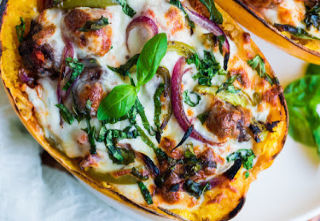 Pasta night needn’t be a thing of the past when you adopt Primal Blueprint eating principles. While there’s a host of packaged paleo and even keto pasta choices out there these days, the simplest, whole food option is the humble spaghetti squash.
Pasta night needn’t be a thing of the past when you adopt Primal Blueprint eating principles. While there’s a host of packaged paleo and even keto pasta choices out there these days, the simplest, whole food option is the humble spaghetti squash.
Here we’ve taken full advantage by using the remaining shell as a festive bowl once we’ve shredded the “noodles” from the inside. With meatballs, peppers, onions, marinara and mozzarella, you’ll enjoy all the flavors of your favorite pizza.
Italian Spaghetti Squash
Servings: 2
Prep Time: 20 minutes
Cook Time: 75 minutes
Ingredients:
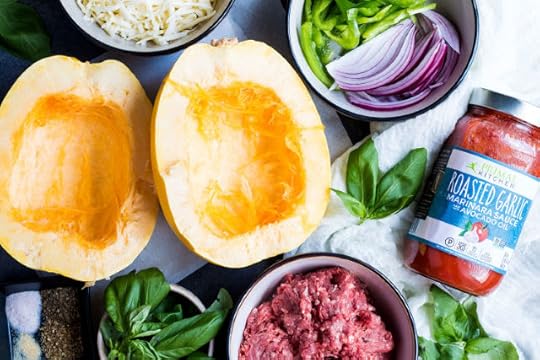
2 small/medium or 1 large Spaghetti Squash (about 6 cups cooked)
1.5 Tbsp. Primal Kitchen® Avocado Oil or Olive Oil, divided
1 lb. 85/15 Grass-fed Ground Beef
1/2 tsp. Salt
1/2 tsp. Garlic Powder
1/2 tsp. Dried Oregano
1/2 tsp. Dried Basil
1 Green Bell Pepper, thinly sliced
1/2 cup thinly sliced Red Onion
2 cups Primal Kitchen Roasted Garlic or Tomato Basil Marinara Sauce
2 Tbsp. Basil Leaves, whole or torn in half
3 oz. Shredded Full-Fat Mozzarella
2 Tbsp. Shredded Basil
Instructions:
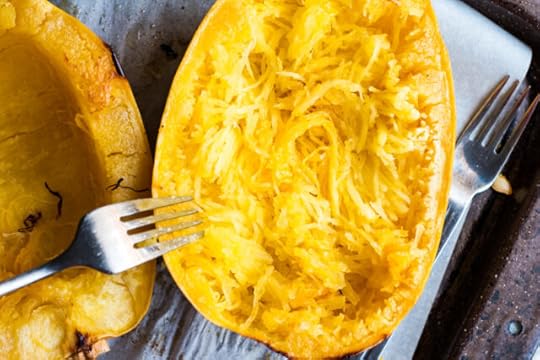
Preheat your oven to 375 degrees Fahrenheit. Slice a spaghetti squash lengthwise and scoop out the seeds. Rub a ½ tablespoon of oil all over the outside and inside of the spaghetti squash. Place the spaghetti squash halves cut-side down on a parchment covered sheet pan and bake until just tender. The timing will depend on the size of your squash, but aim to check on them around 30-40 minutes and then continue cooking as needed.
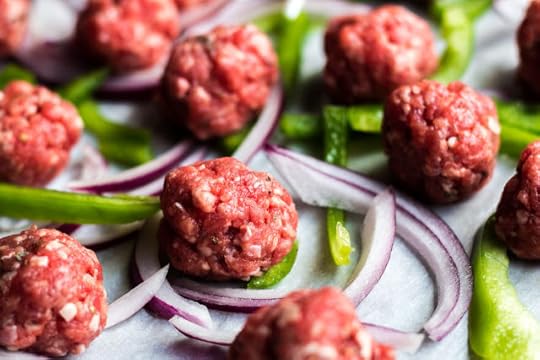
While the spaghetti squash is cooking, combine the beef, salt, garlic powder, oregano and basil in a bowl. Form 20-24 small meatballs and set aside. Toss the pepper and onion slices in the remaining oil and arrange the slices and meatballs on a sheet pan. Bake for 15-20 minutes, or until the meatballs are cooked through and have an internal temperature of about 160 degrees.
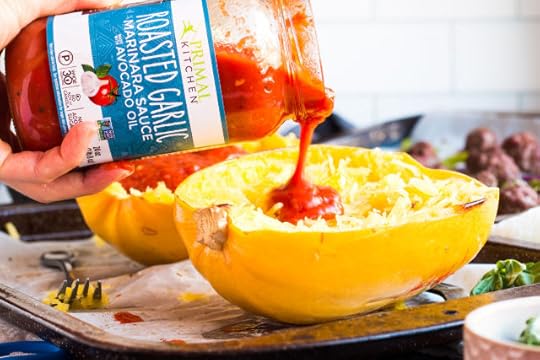
Flip the spaghetti squash halves over and use two forks to separate the strands of spaghetti squash. Continue until all of the squash is fluffed up. Pour the marinara sauce all over the spaghetti squash strands. Arrange the mini meatballs and about half of peppers and onions in the spaghetti squash halves. Top with the torn basil leaves.
Turn on your oven’s broiler. Sprinkle the mozzarella cheese over the spaghetti squash and toppings. Top with the remaining pepper and onion slices. Once the broiler is hot, carefully place the spaghetti squash halves under the broiler. Broil for a few minutes until the cheese is melted and slightly browned. Remove the squash from the oven and top with shredded basil before serving.
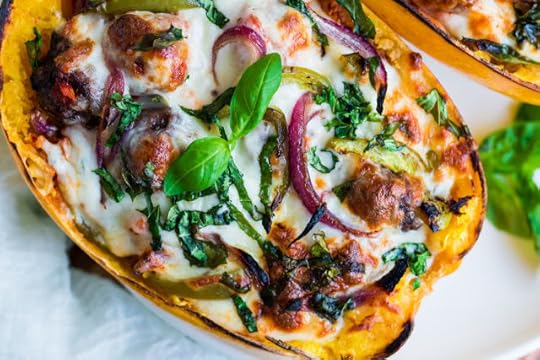
Nutritional Information (¼ of recipe):
Calories: 465
Total Carbs: 27 grams
Net Carbs: 23 grams
Fat: 29 grams
Protein: 27 grams


The post Spaghetti Squash Bowl appeared first on Mark's Daily Apple.



3 Spaghetti Squash Bowl Recipes
 Pasta night needn’t be a thing of the past when you adopt Primal Blueprint eating principles. While there’s a host of packaged paleo and even keto pasta choices out there these days, the simplest, whole food option is the humble spaghetti squash.
Pasta night needn’t be a thing of the past when you adopt Primal Blueprint eating principles. While there’s a host of packaged paleo and even keto pasta choices out there these days, the simplest, whole food option is the humble spaghetti squash.
Here we’ve taken full advantage by using the remaining shell as a festive bowl once we’ve shredded the “noodles” from the inside. Make yours a totally custom creation with these three delicious Primal recipes.
Italian Spaghetti Squash
Servings: 2
Prep Time: 20 minutes
Cook Time: 75 minutes
Ingredients:

1/2 tsp onion powder
2 cloves garlic, minced
1 tsp salt
1 tsp dried oregano
1 tsp dried thyme
6 fresh basil leaves
1 cup spaghetti squash, cooked and “shredded”
1/2 medium red onion, sliced
1 green pepper, sliced
8 oz ground beef
1 1/2 cup Primal Kitchen® Roasted Garlic Marinara Sauce
1 cup mozzarella cheese
Instructions:
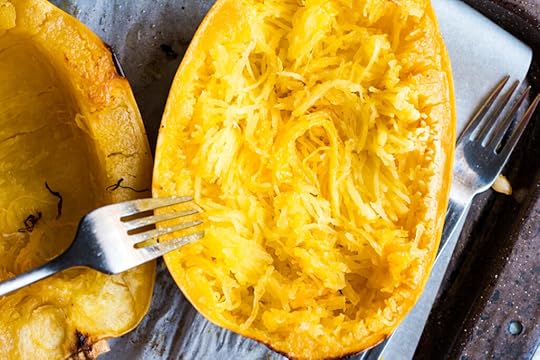
Slice spaghetti squash and scoop out seeds from inside.
Bake in a dish with a small layer of water for about 40 minutes at 400 F.
Let squash cool and use a fork to separate “noodles.”

Chop bell pepper and red onion into thin slices.
Mix the ground beef with herbs and salt. Make 1-inch meatballs.
Place meatballs and veggies on a parchment lined roasting pan, and cook at 400 degrees Fahrenheit for 15 minutes. (Make sure meatball centers are full cooked.)

Add roasted meat and veggie mixture and warmed marinara to spaghetti squash and combine.
Add sliced strips of basil.
Top with mozzarella cheese and bake for another 10-15 minutes. Enjoy!

Sound (and look) tempting? Here are two more versions for spaghetti squash bowls.
“Cheesy” Spaghetti Squash
Ingredients:
1 Tbsp nutritional yeast
0.5 Tbsp lemon juice
0.25 tsp garlic powder
1 cup spaghetti squash, cooked and “shredded”
2 tsp olive oil
6 oz tempeh, cooked
2 cups kale, loosely chopped
Instructions:
Slice spaghetti squash and scoop out seeds from inside.
Bake in a dish with a small layer of water for about 40 minutes at 400 F.
Let squash cool and use a fork to separate “noodles.”
Scoop out the spaghetti squash (keep 1 cup for future meals, and use the remaining).
Heat a skillet over medium heat and add olive oil.
Add tempeh and cook until browned.
Add kale and slightly steam.
Add nutritional yeast, lemon juice, and garlic powder.
Add spaghetti squash and toss gently to combine.
Leftover Spaghetti Squash With Mushrooms
1 cup mushrooms, sliced
½ cup peppers, sliced
2 cups spinach, washed
1 cup pre-made spaghetti squash, cooked and “shredded”
6 oz chipotle style seitan
¼ tsp chili powder
Instructions:
Use leftover spaghetti squash and heat up in microwave.
Slice mushrooms and peppers.
In a skillet, sauté the seitan with peppers, mushroom, spinach and seasonings.
Toss all together and enjoy!


The post 3 Spaghetti Squash Bowl Recipes appeared first on Mark's Daily Apple.



October 11, 2019
Weekly Link Love — Edition 50

Research of the Week
Overtrained athletes aren’t as good at delaying gratification.
Dogs are more effective than statins.
PUFAs linked to skin cancer, saturated fats neutral, MUFA protective.
Zebra stripes ward off biting flies, even when you paint them on cows.
Dreams about social media are rare, but they’re more common in the neurotic and extraverted.
A lower omega-6:omega-3 ratio is better for liver health in the context of alcohol injury.
New Primal Blueprint Podcasts

Episode 380: Arriane Alexander: Host Elle Russ chats with actor and business coach Arriane Alexander.

Episode 381: Fitness Philosophy, Being Patient, Getting Back in Shape, and Carb/Fasting Strategies: Host Brad Kearns covers a wide range of topics.

Primal Health Coach Radio, Episode 29: Laura and Erin chat with JJ Virgin.
Each week, select Mark’s Daily Apple blog posts are prepared as Primal Blueprint Podcasts. Need to catch up on reading, but don’t have the time? Prefer to listen to articles while on the go? Check out the new blog post podcasts below, and subscribe to the Primal Blueprint Podcast here so you never miss an episode.
Media, Schmedia
Six Thai elephants give their lives trying to save each other from drowning.
According to the London mayor’s new food rules, bacon and butter are junk food.
Interesting Blog Posts
Social Notes
Everything Else
What they’re aiming to impose across the entire world.
Things I’m Up to and Interested In
I’m not surprised: A brief diet intervention (other than the 3 servings of whole grains, everything else looked quite solid) reduced depression symptoms in young adults with depressive symptoms and habitually poor dietary intake.
Now that’s what I call BPA-free: Prehistoric humans used bones as “cans” to store marrow.
I couldn’t help but notice: This planet has a long history of hosting vast numbers of ruminants.
I’ll visit, but I won’t live there if this goes through: The cities committed to fully converting to a “planetary health diet” by 2030.
As long as it doesn’t turn out like the Aztec Empire with pyramids of human skulls: Integrating psychedelics with society.
Question I’m Asking
What do you think about Singapore’s ban on sugary drink ads?
Recipe Corner
Instant Pot vegetable soup. Feel free to add meat.
Shepherd’s pie, with cauliflower instead of potato.
Time Capsule
One year ago (Oct 5 – Oct 11)
Is Monk Fruit Sweetener a Healthy Choice? – I think so.
A Primal Guide to Prostate Health– Take care of yourself back there.
Comment of the Week
“I love that sort of thing. I spent a long train ride sitting next to a blind man. It was fascinating and I often think of him and hope he’s doing all right.”
– Beautiful, Angelica. I have similar experiences.

The post Weekly Link Love — Edition 50 appeared first on Mark's Daily Apple.



Keto and Cancer: Where Do We Stand?
 The ketogenic diet has exploded in popularity over the last few years. Hordes of people are using it to lose body fat, overcome metabolic diseases, improve their endurance performance, attain steady energy levels, make their brain work better, and control seizures. And increasing numbers of researchers and personal experimenters are even exploring the utility of ketogenic diets in preventing and/or treating cancer. After all, back in the early part of the 20th century, Warburg discovered an important characteristic of most cancer cells: they generate their energy by burning glucose. If a particular cancer loves glucose, what happens if you reduce its presence in your body and start burning fat and ketones instead?
The ketogenic diet has exploded in popularity over the last few years. Hordes of people are using it to lose body fat, overcome metabolic diseases, improve their endurance performance, attain steady energy levels, make their brain work better, and control seizures. And increasing numbers of researchers and personal experimenters are even exploring the utility of ketogenic diets in preventing and/or treating cancer. After all, back in the early part of the 20th century, Warburg discovered an important characteristic of most cancer cells: they generate their energy by burning glucose. If a particular cancer loves glucose, what happens if you reduce its presence in your body and start burning fat and ketones instead?
It’s taken a while, but the research community is finally beginning to take a few swings at this and similar questions.
So, what do we know?
First, let’s just go through a few recent human studies and case studies.
Keto and Cancer Treatment
Women with endometrial or ovarian cancer improved energy levels, appetite, and physical function on a ketogenic diet.
A Bayesian approach to studying the effects of ketogenic diets in humans and animals with high grade glioma (a brain cancer) found an “overall survival-prolonging effect.”
In gliomas, an analysis of available case studies using ketogenic diets found increased overall or progression-free survival. These were not randomized controlled trials, however, so they say nothing definitive.
A recent review paper gives a good overview of the current state of ketogenic diet and cancer research, finding that:
Ketosis targets tumor metabolism.
Ketosis improves effectiveness of conventional therapies.
Ketosis has favorable effects of anti-cancer gene expression.
One thing you might notice is that there are no studies showing that standalone ketogenic diets cure cancer. There aren’t very many randomized controlled trials in general.
What there are are studies showing that ketogenic diets are safe and potentially effective adjuvant treatments—treatments that supplement conventional cancer treatments. You don’t see keto “defeating” cancer alone. You see keto enhancing the effect of chemotherapy. You see keto enhancing the effect of radiation. You see keto protecting normal cells and increasing the vulnerability of cancer cells to conventional treatment.
That’s not to say that keto can’t beat cancer. Maybe it can. But the clinical research simply isn’t there to say one way or the other.
Where keto seems even more promising is in prevention of cancer.
Keto and Cancer Prevention
Diabetes is a disease of carbohydrate intolerance. It’s a disease in which carbohydrate consumption results in elevated blood sugar, exaggerated insulin response. The way most people with diabetes eat leads to chronically high levels of insulin and blood sugar. Yeah, yeah, I know about all the badass Primal eaters who are “technically” diabetic but keep their blood sugar pristine and insulin minimized by watching what they eat, exercising regularly, and just generally leading a healthy lifestyle—but those people aren’t a large enough a group to have an effect on the category known as (and studied as) “diabetics.” Most people with diabetes unfortunately keep eating the same junk that got them there.
What does research say about the cancer rate of most people with diabetes? It’s usually higher.
One of the most consistent risk factors for many types of cancer is having diabetes and experiencing all the metabolic fallout that entails—high fasting insulin, insulin resistance, elevated blood glucose. Cancers of the liver, pancreas, breast, endometrium, bladder, and kidney all have strong associations with type 2 diabetes. This should come as no surprise. Not only do many cancers thrive on glucose as fuel, the high insulin levels typical of people with diabetes and insulin resistance increase the availability of growth factors that promote cancer growth.
Meanwhile, therapies that are known to reduce the symptoms of diabetes—lower fasting insulin, increase insulin sensitivity, normalize blood sugar, etc—tend to lower the risk of cancer. A perfect example is metformin.
Metformin activates AMPK, the same autophagy pathway activated by exercise, fasting, polyphenol consumption, and reduced calorie intake. It lowers blood sugar, increases insulin sensitivity, and extends the lifespan of type 2 diabetics.
Metformin also seems to protect against cancer. It lowers hyperinsulinemia and may protect against insulin-related cancers (breast, colon, etc). Early treatment during adolescence, for example, protects rats against later tumor growth.
What does this have to do with ketogenic diets?
Ketogenic diets have many similar effects. They activate AMPK. They lower blood sugar. They’re great for fat and weight loss, which enhances insulin sensitivity. Recently, researchers have even used ketogenic diets to resolve type 2 diabetes.
Now, not all cancers are linked to diabetes. For example, diabetes doesn’t increase the risk of gastric cancer. That’s because it’s linked to bacterial infection, not elevated blood sugar. And that’s why taking metformin doesn’t reduce the risk of gastric cancer. This actually supports my hypothesis that, when diabetes does not increase the risk of a cancer, neither does metformin reduce it—like gastric cancer. Diabetes doesn’t increase it, so metformin doesn’t reduce it. That’s the mechanism in play.
Nor do all cancers burn glucose exclusively. Some thrive in a ketogenic environment.
There is a mutation called BRAF V600E in certain cancer cells that allows them to utilize ketone bodies to stimulate growth. About 50% of melanoma, 10% of colorectal cancer, 100% of hairy cell leukemia, and 5% of multiple myeloma cases exhibit the ketone-utilizing BRAF V600E mutation. Indeed, a cancer cell’s inability to break down and metabolize ketone bodies is the best predictor of whether a ketogenic diet can even help against a given cancer.
But if we’re talking prevention. If we accept that not developing diabetes—all else being equal— probably reduces the risk of getting cancer, then using ketosis to improve all the same symptoms linked to diabetes should also reduce the risk of getting cancer. And if it doesn’t reduce the risk, it probably won’t hurt. I mean, is there a doctor alive who claims that increasing insulin sensitivity, lowering hyperinsulinemia, and losing body fat will increase the risk of cancer?
A Few Takeaways To Consider
As I see it—and this is not medical advice—the most promising use of ketogenic diets in cancer are as follows.
Adjuvant therapy: Using ketosis to enhance the efficacy of conventional therapies like chemotherapy and radiation, increasing the susceptibility of cancer cells to treatment and increasing survival of healthy host cells.
Prevention: Using ketosis (whether intermittently or long term) to lower fasting blood glucose, reduce diabetes risk (or resolve extant diabetes), and improve your ability to burn fat and not rely on exogenous glucose so much should in theory reduce your risk of most cancers.
Whatever you do, if you’re an actual cancer patient, discuss this with your doctor. Make sure your particular variety of cancer isn’t partial to ketones. Make sure it’s one of the cancers that actually craves glucose. If you end up with a cancer that thrives on ketone bodies, and you go deep into perpetual ketosis, you could be making an enormous mistake.
But the bottom line is that, assuming you don’t already have one of the cancers known to utilize ketones, going into ketosis from time to time isn’t going to hurt—and it will probably help reduce the risk of cancer.
I’m going to close this post with an anecdote from one of my employees. His father passed away a dozen years ago from multiple myeloma, a type of white blood cell cancer. This was before he worked at Primal Nutrition; he was just getting involved in alternative forms of health and nutrition research. What struck him most, particularly in retrospect, was how his father’s appetite changed during his battle with cancer. He began craving candy—Reese’s peanut butter cups, Hershey’s kisses, Now-and-Laters, and all other kinds. As he says it, looking at his dad’s snack drawer was like looking at the archetypal bag of Halloween candy.
I don’t know if this is evidence of anything. Can cancer actually tap into your specific appetites? Can it change how you perceive and desire specific foods? Was his father actually being programmed by his cancer to over-consume sugar?
Who knows.
What I do know is that no one needs garbage candy. A few seconds of momentary gustatory pleasure, followed by regret and the incessant need to repeat—is it worth it? Is it worth the off chance that eating lots of sugar feeds and promotes cancer? Don’t do it, folks. I know my longtime readers are right there with me. I know you guys who’ve been here from the beginning are probably getting egged on Halloween because you’re giving out collagen packets and mini-kettlebells. But if you’re new to this site and way of eating in general—maybe a co-worker passed my info along to you, maybe you’re trying to make a big change in the way you eat and live—avoiding the obviously terrible-for-you stuff like candy and baked goods is the biggest change you can make. And not just for cancer.
So, do I want you to walk away from this post thinking that keto is a cancer cure? No. I’m a fan of ketosis, and I think almost everyone should spend time in that metabolic state, but I don’t consider it to be magical. The jury is definitely still out. Does ketosis look like a strong candidate for improving efficacy of various therapies in certain cancer patients? Yes. Can keto improve health markers shown to reduce a person’s risk of getting cancer in the first place? Yes.
The keys to good health are generally speaking pretty consistent.
Maintain good insulin sensitivity.
Avoid glucose intolerance.
Get plenty of sleep.
Consume hormetic stressors.
Avoid obesity. Lose body fat.
Exercise, or at least move every day.
Dip into ketosis on a regular basis, either from ketogenic dieting, fasting, meal skipping, or (non-chronic) hard training—or all of the above.
There’s no guarantee against cancer, but I think the advice I just mentioned supports a good fighting chance.
Take care, everyone. Be well.

The post Keto and Cancer: Where Do We Stand? appeared first on Mark's Daily Apple.



Mark Sisson's Blog
- Mark Sisson's profile
- 199 followers



